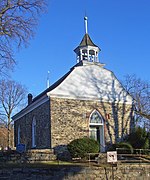Sleepy Hollow, New York

Sleepy Hollow is a village in the town of Mount Pleasant, in Westchester County, New York, United States. The village is located on the east bank of the Hudson River, approximately 30 miles (48 km) north of New York City, and is served by the Philipse Manor stop on the Metro-North Hudson Line. To the south of Sleepy Hollow is the village of Tarrytown, and to the north and east are unincorporated parts of Mount Pleasant. The population of the village at the 2020 census was 9,986.Originally incorporated as North Tarrytown in the late 19th century, in 1996 the village officially adopted the traditional name for the area. The village is known internationally through "The Legend of Sleepy Hollow", an 1820 short story about the local area and its infamous specter, the Headless Horseman, written by Washington Irving, who lived in Tarrytown and is buried in Sleepy Hollow Cemetery. Owing to this story, as well as the village's roots in early American history and folklore, Sleepy Hollow is considered by some to be one of the "most haunted places in the world". Paradoxically, Sleepy Hollow has also been designated "the safest small 'city' [i.e., under 100,000 residents] in America".The village is home to the Philipsburg Manor House and the Old Dutch Church of Sleepy Hollow, as well as the Sleepy Hollow Cemetery, where in addition to Irving, numerous other notable people are buried.
Excerpt from the Wikipedia article Sleepy Hollow, New York (License: CC BY-SA 3.0, Authors, Images).Sleepy Hollow, New York
Merlin Avenue,
Geographical coordinates (GPS) Address Nearby Places Show on map
Geographical coordinates (GPS)
| Latitude | Longitude |
|---|---|
| N 41.091944444444 ° | E -73.864444444444 ° |
Address
Merlin Avenue 85
10591
New York, United States
Open on Google Maps








